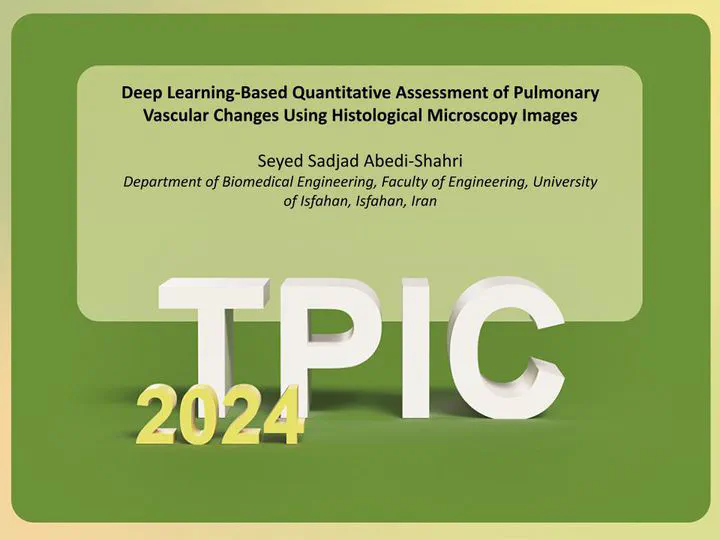TPIC 2024 - Oral Presentation

Abstract
Background: Pulmonary hypertension (PH) is associated with structural remodeling of pulmonary circulation vessels, leading to increased arterial pressure. The hypertrophy index, representing the ratio of vascular wall area to total vessel area, is a key metric for evaluating these structural changes. Manual analysis of histological images for this purpose is time-consuming and requires expertise. This study introduces a deep learning-based method designed to automate quantitative assessments of vascular changes from histological microscopy images, improving the efficiency and scalability of analysis.
Objective: The objective of this research is to develop and validate a deep learning model for predicting the hypertrophy index from histological microscopy images of pulmonary circulation vessels, focusing on optimizing model architecture and hyperparameters to achieve high accuracy while reducing overfitting.
Methods: The dataset comprises 609 histological images of pulmonary vessels from preclinical studies using a rat model of chronic thromboembolic pulmonary hypertension (CTEPH), prepared through hematoxylin and eosin (H&E) staining (resolution: 0.34 μm/px). Each image includes detailed annotations of vascular parameters such as vessel diameter and hypertrophy index. A convolutional neural network (CNN) based on ResNet18 was employed, with modifications to the fully connected layers to improve regression performance. Images were preprocessed using a pipeline that included resizing, normalization, and advanced augmentation techniques like elastic transformation to address overfitting. Multiple rounds of hyperparameter tuning were conducted along with architectural changes, to improve model generalization and performance.
Results: The refined model demonstrated robust predictive performance, with strong correlation observed between predicted and true hypertrophy index values across the test set (MAE of 4.2475 and an R² score of 0.9320). Through iterative adjustments to the architecture and hyperparameters, the model effectively mitigated overfitting and achieved stable predictions. Compared to traditional manual analysis, which typically requires 15-20 minutes per image and is subject to inter-observer variability, our model processes images in seconds with consistent results. This represents a significant improvement in both speed and reliability over existing methods. These results indicate that the proposed deep learning model can serve as a reliable tool for automating the analysis of pulmonary vascular changes.
Conclusion: This deep learning-based framework offers an efficient alternative to manual quantification of vascular remodeling in pulmonary hypertension. By automating hypertrophy index prediction, this approach has significant potential for both research and clinical applications in the analysis of pulmonary circulation vessels.